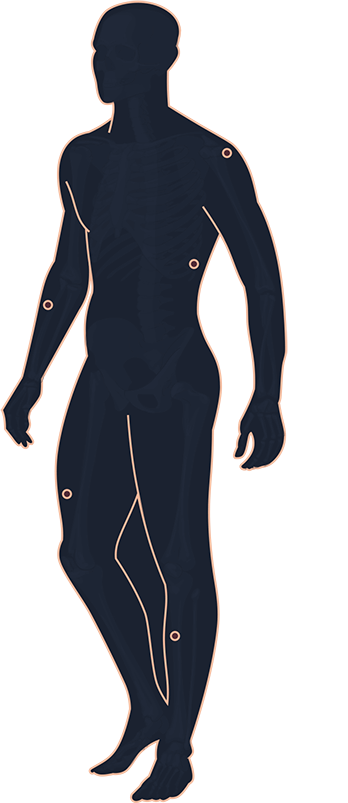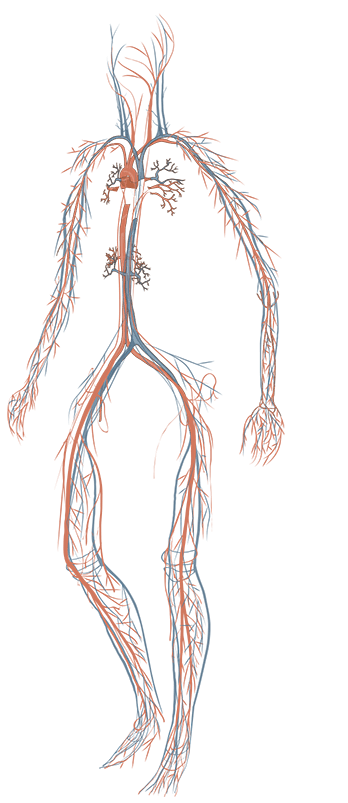for early detection of genetic susceptibility to the 28 most common diseases in the world.
Talk with us
by e-mail (anytime):
 EN | USD
EN | USD
Talk with us
by e-mail (anytime):
by e-mail (anytime):
 EN | USD
EN | USD
by e-mail (anytime):
for early detection of genetic susceptibility to the 28 most common diseases in the world.
We conduct a full range of research and analysis of your DNA for the possible presence or susceptibility to the most dangerous diseases in the world.
Basal-cell carcinoma (basalioma) is the most widespread malignant tumor. Almost 40% of the elderly population worldwide is affected by this disease.
Peripheral vascular disease (PVD) is a group of diseases characterized by narrowing of the lumen of the arteries supplying the limbs and internal organs. The danger of PVD lies in the deterioration of the function of the affected organ, with the risk of losing it altogether.
Alzheimer's disease is a serious disorder of the central nervous system mainly affecting the elderly. Statistics show that over 5% of people aged 65–80 suffer from this condition worldwide.
Graves' disease is the most common cause of over-secretion of hormones from the thyroid gland. It is a multi-factor condition that occurs when a hereditary predisposition is combined with the effect of certain adverse factors.
Venous thromboembolism is a group of diseases caused by the formation of a thrombus and the disruption of blood flow along the affected vessel. Thromboembolism is a dangerous condition that threatens the health and the life of the patient.
A brain aneurysm (also known as a cerebral or intracranial aneurysm) is a dangerous pathological condition in which an area of a blood vessel in the brain becomes excessively stretched. Statistics show that about 1% of the world population have an unsuspected cerebral aneurysm.
Age-related macular degeneration (Age-related macular degeneration, senile macular degeneration, DMLA) — one of the most common retina diseases. Macular degeneration takes the sad first place in the list of causes of loss of vision in elderly people.
Systemic lupus erythematosus (SLE, lupus, lupus) is a malady with a complex clinical performance, manifested by skin, heart, kidneys, lungs, joints, nervous system damage. The world incidence rate varies within the scope of 0.2-0.05% of the population.
Glaucoma is a dangerous eye condition characterized by high intraocular fluid pressure with characteristic changes in visual function. Without adequate treatment, it can lead to atrophy of the optic nerve and a complete loss of sight.
Type 1 diabetes mellitus — is one of the most urgent problems of pediatric and adolescent endocrinology. Disease requires radical revision of lifestyle, serious material costs (in some countries, compensated by the state) and constant doctor attention for prevention of dangerous complications.
Type 2 diabetes mellitus — is often occurring endocrine pathology, associated with decrease of absorption of glucose by tissues. Incidence is steadily increasing in all countries of the world: this disease affects about 5% of the world's population.
Coronary heart disease (CHD) is one of the most common diseases of the cardiovascular system. The disease is the absolute leading cause of death and loss of work capacity.
Colorectal cancer (bowel cancer) is among the most common malignant tumors. Despite the relatively slow progression of the disease, late detection causes high mortality - as much as 60% of all cases diagnosed.
Melanoma is a dangerous tumorous disease affecting the skin and sometimes the retina and mucous membranes. This is a malignant tumor distinguished by its propensity to spread and metastasize.
Migraine is a neurological disease whose principal symptom is a primary paroxysmal headache not related to organic nerve-tissue damage. Over 10% of the world’s population suffers from this condition.
Hair loss (alopecia) — is a widespread problem affecting mainly middle-aged men. If there is a hereditary burden, the first signs of hair loss may appear much earlier, at the age of 30, 25 or even 20.
Obesity is one of the most urgent problems of modern mankind. The disease is based on deposition of excess adipopexia, which leads to severe consequences for the entire body.
Exfoliative glaucoma — is eye disease with a complex clinical picture and well-defined territoriality of extension. Disease progression leads to visual deterioration, and to complete loose of it.
Psoriasis is one of the most common skin diseases. The disease is characterized by excessive overgrowth of the epithelium and a typical spots with peeling. Psoriasis significantly worsens quality of patients life and can cause permanent disability.
Stomach cancer is one of the most common malignant tumors. Worldwide, about one million people a year develop stomach cancer, and over half of them die within a year.
Lung cancer is the most common malignant tumor, and the leading cause of death among cancer patients. About three-quarters of first diagnoses of lung cancer are stage III-IV tumors.
Breast cancer is a malignant tumor with frank gene conditionality of disease. This is the second most frequent occurrence and mortality rate of oncological disease in the world.
Bladder cancer is a malignant tumor with pronounced geographical zonality of morbidity. This tumor accounts for about 4-5% of all neoplasms.
Prostate cancer is one of the most frequent malignant tumors in men. In many countries in the list of oncological diseases, prostate cancer ranks the 2nd or the 3rd place in frequency and in reasons of mortality of male patients.
Multiple sclerosis (disseminated sclerosis) is a neurological disease of an autoimmune nature with generalized conduction abnormality of nerve impulses caused by damage of myelin sheath of nerve fibers. Disease progression leads to extensive motor impairment, deterioration of quality of life and a reduction of its duration.
Rheumatoid arthritis is a chronic disease from the group of collagenoses, mainly affecting small joints. The progressive course leads to joint deformation with persistent disability.
Atrial fibrillation (auricular fibrillation) — is one of the most common forms of rhythm disturbance. About 2% of the world's population suffers from this dangerous cardiovascular disease, which increases the risk of thrombembolia and other vascular accidents.
Celiac disease is a disease that affects mucous membrane of small intestine and is associated with gluten (cellulose) intolerance and some other proteins of similar structure that make up wheat, barley and rye. The prevalence of this anomaly varies between 0.3 and 1% of population.























Find out how it works and order the DNA test for early detection of a genetic susceptibility to the 28 most common diseases in the world right now!
Every day, more and more people all over the world find out about our genetic test, many of them have already become our customers and have received their complete DNA analysis.
When ordering a complete DNA analysis from us, you get not only an easy-to-use product but also a genetic passport with full details and infographics of your test results.



Many satisfied customers have already taken advantage of our services and were absolutely satisfied. In confirmation, we give a few thank-you reviews:
Many satisfied customers have already taken advantage of our services and were absolutely satisfied. In confirmation, we give a few thank-you reviews: